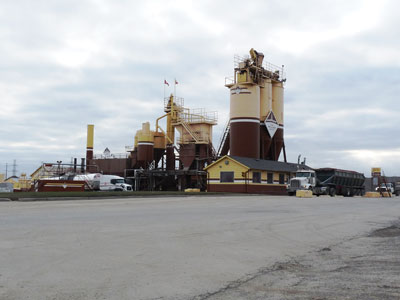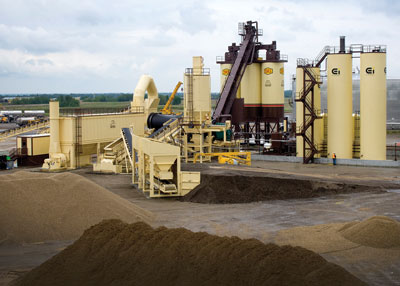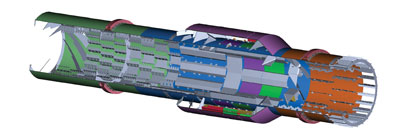
Features
Roads & Paving
Technology
Making Asphalt Paving Easier
A look at new products and technologies.
December 3, 2012 By Treena Hein
Among the most exciting new techniques and associated technologies that
have been developed in asphalt paving over the last decade is warm mix
asphalt (WMA).
Among the most exciting new techniques and associated technologies that have been developed in asphalt paving over the last decade is warm mix asphalt (WMA). “Warm mix is made through an additive such as organic waxes to the asphalt cement, or through using a foaming device that’s available from several different equipment suppliers,” says Donn Bernal, general manager of materials at Aecon in Brampton, Ont. “We’ve been introducing WMA to our customers and trying to use it more over the last three years.” Aecon uses a Gencor foaming WMA device at its Brampton plant, and Bernal is happy with its performance. “It works well – you don’t even realize you’re using it,” he says. “There is no ongoing cost as you only need to add water.”
 |
|
| Miller Paving’s batch plant in Markham, Ont., features equipment purchased from several manufacturers in order to construct the most functional plant to meet Miller’s needs.
|
In addition to reducing fuel consumption by 20 to 30% and providing a reduction in emissions, WMA provides quicker compaction time, improved quality due to less aging of the asphalt binder, and potentially a higher content of recycled materials due to the lower working temperatures involved. “The lower compaction temperatures also allow for longer haul distances and a longer paving season as well,” says Trevor Moore, corporate technical director at Miller Paving Limited in Toronto. “The Ontario Ministry of Transportation and several municipalities have increased their WMA use and we anticipate that will continue.”
Terex considers itself a pioneer in WMA foaming technology and has adapted its technology to both counter-flow and parallel-flow asphalt plants. “The Terex WMA foaming device has a simple design with minimal moving parts,” says Terex Roadbuilding district manager Mike Rodriguez. “It’s offered as a fully integrated option with all eight of our asphalt plants, or as a complete stand-alone system that can be fitted to any brand drum mix plant.”
Drum plant developments
Asphalt Drum Mixers’ (ADM’s) new EX series paving plants feature single-drum counterflow technology, with high production volume (100 to 325 tons per hour) in a more compact design. “Our unique single-drum counter-flow system utilizes isolated drying and mixing zones within one drum to achieve an extremely high level of heat transfer, fuel efficiency and mix quality,” says sales manager Steve Shawd. “This results in high asphalt production volume at an extremely low cost-per-ton.” In the ADM single-drum counter-flow system, aggregate and superheated air move in opposite directions, with aggregates entering the feed-entry end of the drum and travelling toward the burner as they are dried. “At the burner nose, the dried material passes behind an isolation ring where liquid asphalt, baghouse dust and RAP (if used) are introduced,” says Shawd. “All materials are mixed in the final drum section, and then are discharged and conveyed to the storage silo.” Shawd notes that counter-flow technology is productive, efficient and environmentally friendly. “It also allows for the introduction of high percentages of recycled material, which is very important in today’s competitive environment,” he says.
 |
|
| A look at the Astec plant, owned by Standard General, located in St. Albert, Alta. This plant has a double RAP aggregate dryer and a separate twin shaft pugmill for mixing liquid asphalt with rock.
|
Several new changes have been made to Terex’s counter-flow drum plant design over the last decade. The E3 series features unique saw-tooth veiling flights – the most homogenous and evenly distributed aggregate veil on the market – in the drying section of the plant, which provides unmatched drying efficiency, says Rodriguez. “The E3 also features a standard RAP (reclaimed asphalt pavement) collar that introduces RAP to the drum’s virgin aggregate-filled insulating, outer jacket,” he explains. “This outer jacket comingles the hot and dry virgin aggregate with the cooler, wetter RAP, transferring and evenly distributing heat energy.” The blended material then travels around the drum’s combustion zone, wrapping and insulating this zone with a layer of materials that further absorbs radiated energy and conducts burner heat energy through the E3’s stainless steel panels. “This extensive preconditioning of RAP and the industry’s most thorough use of available burner energy allows the Terex E3 drum to return high fuel efficiency,” says Rodriguez.
Comparing plant types
Drum plants and batch plants each provide different strengths. “Drum plants operate at a higher rate of production for a given drum size, since the mixing process is continuous,” notes Miller Paving’s Moore. “They can reach higher recycled percentages than batch plants because the RAP is added in the drum where some added heat exchange can occur,” he says.
 |
|
| Terex’s counter-flow drum plant design.
|
The strength of a batch plant, says Moore, is in its ability to switch mix specifications quickly if needed. “Batch plants require more steps to produce hot mix, and those steps can be a benefit, if mix versatility is required,” he says, “but it can make the plant less desirable for someone producing the same mix all day.” He also points to the fact that the percentage of RAP that can be added to a mix is limited by the maximum amount of heat that the batch plant can add to the virgin aggregate. “Most batch plants have the ability to meet most government specifications, but the fact that a drum plant reduces the hot mix process to its essentials is its big advantage over a batch plant,” Moore says. “And, the lack of versatility of a drum plant can be overcome if enough silos are present.”
Similarly, stationary and portable asphalt plants each offer advantages that can provide the best solution for a particular job. However, Rodriguez points out that stationary plants typically provide a wider array of mix designs. “This is because stationary plants typically feature a larger number of cold feed bins as well as RAP bins,” he says. “With portable plants, adding additional bins is possible but not typically done as it adds cost.” Additionally, stationary plants invariably feature multiple storage silos in which to store the wider array of mix designs and therefore provide more flexibility. However, Rodriguez adds that “while an argument can be made that stationary plants can provide high-quality warm mixes, one has to consider the retention of quality of mixes that can be afforded by having the plant as close to the paving site as possible with a portable plant.”
Terex has introduced a Super Portable (SP) line of counter-flow asphalt plants designed to reduce the mobilization and demobilization costs for the contractor by nearly half. The SP plants are available in 150-, 225- and 275-ton-per-hour performance levels. A size below 100 tons per hour that features the entire plant on as few as three portable chassis units has a planned introduction in 2013 in appropriate markets.
Astec Industries offers portable plants under the Astec and Dillman brand names.
Astec recently took over production of asphalt plants by CEI Enterprises (which was a subsidiary of Astec), which included the Nomad and Rap King series of portable plants. Rap King plants are highly efficient counter-flow plants, able to produce mix with up to 50% RAP. With this consolidation, Astec now offers asphalt plants that produce between 72 and 450 tonnes per hour, and the company is also working on smaller plants in the 27- to 162-tonne production range.
| New pavements New Quiet Pavements that provide reduced traffic noise include modified rubber mixes. The Ontario Ministry of Transportation is currently running trials on them. They are thought to produce quieter running surfaces with more durability because of increased liquid asphalt content. Rubber can be added into the liquid asphalt at the terminal (wet process), added at the asphalt plant as a product into liquid asphalt prior to entering the plant (also called wet process), or added at the plant as a separate product with the aggregate prior to mixing (dry process). An open-graded mix is another “quiet pavement.” They are coarse-graded asphalt surfaces that reduce noise pollution. Also known for noise reduction is SMA (Stone Mastic Asphalt), which features high durability because of its higher asphalt content, and high stability because of its stone-on-stone matrix. SMA pavements continue to evolve with recent innovative mix designs and placement methods, thereby optimizing results. Porous asphalt used in place of traditional impervious paving materials decreases the total amount of water runoff leaving a site, promotes infiltration of runoff into the ground, reduces the amount of pollutants carried to a storm drain or waterway, and aids with reducing peak runoff velocity and volume. Asphalt with better endurance – which consists of mixes that resist stripping of the liquid asphalt from the aggregates – is also being developed. Stripping is one of the common results of pavement failure due to water damage (other failure mechanisms include moisture-induced cohesion failure within asphalt, the static charge on fairly newly crushed aggregates, and freezing.) To remove the static charge that exists on newly crushed aggregates within about 30 days of production, lime has been conventionally added to the aggregate prior to producing the hot mix. As an alternative, a liquid anti-stripping agent called polymeric aggregate treatment (PAT), has been developed and is now accepted by the Ministry. PAT provides a protective barrier on the aggregate surface, creating a waterproof coating that repels water while providing an improved bonding with asphalt cement. Such treatment in real terms converts the hydrophilic aggregate (attracted to water) to a hydrophobic aggregate (repelled by water and attracted to oil). The system consists of SBR latex, which is non-toxic, non-flammable, non-corrosive and easy to clean. This latex anti-stripping agent can be easily sprayed on to the aggregates requiring it at the asphalt plant. Lastly, perpetual pavement structures involve the use of “rich bottom mixes” to resist cracking from the bottom up, and allow for future maintenance upgrades to the pavement to involve only the surface. Crack resistance is due to increased asphalt content. (Source: Trevor Moore, corporate technical director, Miller Paving Ltd.) |
Print this page